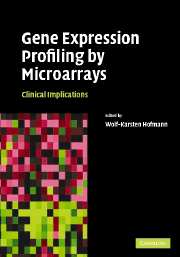Book contents
- Frontmatter
- Contents
- List of contributors
- Foreword
- Introduction
- 1 Technique of microarrays: microarray platforms
- 2 Quantitative quality control of microarray experiments: toward accurate gene expression measurements
- 3 Statistical analysis of gene expression data
- 4 Genomic stratification in patients with heart failure
- 5 Gene expression profiling for the diagnosis of acute leukemias
- 6 Gene expression profiling can distinguish tumor subclasses of breast carcinomas
- 7 Gene expression profiling in lymphoid malignancies
- 8 mRNA profiling of pancreatic beta-cells: investigating mechanisms of diabetes
- 9 Prediction of response and resistance to treatment by gene expression profiling
- Index
- References
4 - Genomic stratification in patients with heart failure
Published online by Cambridge University Press: 05 September 2009
- Frontmatter
- Contents
- List of contributors
- Foreword
- Introduction
- 1 Technique of microarrays: microarray platforms
- 2 Quantitative quality control of microarray experiments: toward accurate gene expression measurements
- 3 Statistical analysis of gene expression data
- 4 Genomic stratification in patients with heart failure
- 5 Gene expression profiling for the diagnosis of acute leukemias
- 6 Gene expression profiling can distinguish tumor subclasses of breast carcinomas
- 7 Gene expression profiling in lymphoid malignancies
- 8 mRNA profiling of pancreatic beta-cells: investigating mechanisms of diabetes
- 9 Prediction of response and resistance to treatment by gene expression profiling
- Index
- References
Summary
Introduction
Cardiovascular disease, or heart failure (HF), continues to be the leading cause of death worldwide, having surpassed infectious disease in the 1990s. Current estimates indicate that chronic HF affects 1–2% of the total population of developed countries [1]. Patients with HF face a dismal prognosis: 5-year survival following diagnosis of any HF is approximately 50%, and 1-year survival for those with end-stage disease is less than 50% [2–4]. In the United States alone, there are approximately 550 000 newly diagnosed cases of HF per year, with numbers continually rising [4]. Furthermore, recent predictions suggest that HF will become the leading cause of all disability by 2020.
HF is a complex and progressive disease with numerous etiologies that involve environmental, genetic and genomic factors. While progress has been made in identifying components that may contribute to HF, our current understanding of the molecular underpinnings of HF remains remarkably limited. Although treatment modalities of recent years have improved disease prognosis, novel insights are required to enhance duration and quality of life further for patients suffering from this debilitating disease. Compounding the complex nature of HF is the recent suggestion that the adult heart expresses as many as 10 000 genes. To unravel the molecular complexities of HF, the rapidly developing field of gene expression profiling by microarrays provides an excellent means by which to investigate genome-wide difference in gene expression profiles associated with cardiovascular disease.
- Type
- Chapter
- Information
- Gene Expression Profiling by MicroarraysClinical Implications, pp. 80 - 105Publisher: Cambridge University PressPrint publication year: 2006



